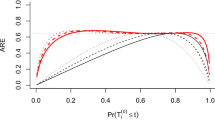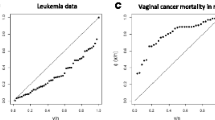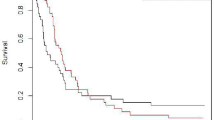Abstract
A fundamental problem with the latent-time framework in competing risks is the lack of identifiability of the joint distribution. Given observed covariates along with assumptions as to the form of their effect, then identifiability may obtain. However it is difficult to check any assumptions about form since a more general model may lose identifiability. This paper considers a general framework for modelling the effect of covariates, with the single assumption that the copula dependency structure of the latent times is invariant to the covariates. This framework consists of a set of functions: the covariate-time transformations. The main result produces bounds on these functions, which are derived solely from the crude incidence functions. These bounds are a useful model checking tool when considering the covariate-time transformation resulting from any particular set of further assumptions. An example is given where the widely-used assumption of independent competing risks is checked.




Similar content being viewed by others
References
Aalen OO (1978) Non-parametric inference for a family of counting processes. Ann Stat 6:701–726
Aalen OO (1980) A model for non-parametric regression analysis of counting processes. In: Klonechi W, Kozek A, Rosiński J (eds) Mathematical statistics and probability. Lecture Notes in Statistics, vol 2. New York, pp. 1–25
Abbring JH, Van Den Berg GJ (2003) The identifiability of the mixed proportional hazards competing risks model. J R Stat Soc, B 65:701–710
Andersen PK, Borgan Ø, Gill RD, Keiding N (1993) Statistical models based on counting processes. Springer, New York
Bennet S (1983) Analysis of survival data by the proportional odds model. Stat Med 2:273–277
Billingsley P (1995) Probability and measure, 3rd edn. Wiley, New York
Clayton DG (1978) A model for association in bivariate lifetables and its application in epidemiological studies of familial tendency in chronic disease incidence. Biometrika 65:141–151
Cooke RM, Morales-Napoles O (2006) Competing risk and the Cox proportional hazard model. J Stat Plan Infer 136(5):1621–1627
Cox DR (1959) The analysis of exponentially distributed life-times with two types of failure. J R Stat Soc B 21:411–421
Cox DR (1972) Regression models and lifetables (with discussion). J R Stat Soc B 34:187–220
Cox DR, Oakes D (1984) Analysis of survival data. Monographs on statistics and applied probability, vol 21, Chapman and Hall, London
Crowder M (1991) On the identifiability crisis in competing risks analysis. Scand J Stat 18:223–233
Crowder M (2001) Classical competing risks. Chapman & Hall/CRC, Boca Raton
Heckman JJ, Honoré BE (1989) The identifiability of the competing risks model. Biometrika 76:325–330
Hoel DG (1972) A representation of mortality data by competing risks. Biometrics 28:475–488
Kalbfleisch JD, Prentice RL (2002) The statistical analysis of failure time data. Wiley series in probability and statistics, 2nd edn. Wiley, New York
Kaplan EL, Meier P (1958) Non-parametric estimation from incomplete observations. J Am Stat Assoc 53:457–481
Lancaster T (1979) Econometric models for the duration of unemployment. Econometrica 47:939–956
Lin DY (1997) Non-parametric inference for cumulative incidence functions in competing risks studies. Stat Med 16:901–910
Nelsen RB (1998) An introduction to copulas, volume 139 of Lecture notes in statistics. Springer, New York
Nelson W (1969) Hazard plotting for incomplete failure data. J Qual Technol 1:27–52
Peterson AV (1976) Bounds for a joint distribution with fixed sub-distribution functions: application to competing risks. Proc Natl Acad Sci, USA 73:11–13
Tsiatis AA (1975) A nonidentifiability aspect of the problem of competing risks. Proc Natl Acad Sci, USA 72:20–22
Vaupel JW, Manton KG, Stallard E (1979) The impact of heterogeneity in individual frailty on the dynamics of mortality. Demography 16:439–454
Zheng M, Klein JP (1995) Estimates of marginal survival for dependent competing risks based on an assumed copula. Biometrika 82:127–38
Author information
Authors and Affiliations
Corresponding author
Appendices
Appendices
A copula invariance
Given a multivariate survival function, S(t), its survival copula (Nelsen 1998, pp. 28–29) is a function \(C:[0,1]^k\mapsto [0,1]\) with the property that C(1,...,1,u,1,...,1) = u and that S(t) = C{S 1(t 1), ..., S k (t k )}, where S i (t i ) is the marginal survival function for T i .
If the effect of a covariate, Z, can be represented in the form
then it follows that \(\phi_{i}(t,z)=S_{i}^{-1}\{S_{i}(t|Z=z)|Z=\mathcal{Z}\}\). Hence if we denote C z to be the survival copula of the joint survival function conditional on Z = z, it follows that
Hence our assumption about the form of the CTT implies that the survival copula is invariant to the value of the covariate. Given that the copula describes the dependency structure of a multivariate distribution (Nelsen 1998, chapter 5) this gives a useful insight into the implications of assumption (4).
B Lemmas
Lemma B.1.
For all doubly indexed sets A ij ,
Proof
Consider
Since \(A_{im} \cap A_{nj}^{c}=\emptyset\) for m = j, n = i
□
Lemma B.2.
For any subset, \(\mathcal{C}\), of the indices, i, over which the random variables T i are defined, define \(A= \bigcup_{i \in \mathcal{C}} \bigcap_{j \neq i} \{ T_{i} < T_{j} \}\), and, \(B= \bigcup_{i \in \mathcal{C}} \bigcap_{j \not\in \mathcal{C}} \{ T_{i} < T_{j} \}\), then A = B.
Proof
Since
we have that \(A \subseteq B\).
Consider
Swapping the indices i and j, and using lemma B.1 we have,
Clearly \(\bigcap_{j \in \mathcal{C}} \{T_{i}< T_{j}\} \supseteq \bigcap_{j \neq i} \{ T_{i}< T_{j}\}\), hence
where the last equality arises from the fact that \(\bigcap_{j\neq i}\{ T_{i}< T_{j}\}\) partitions Ω, the sample space.
So we have \(A\subseteq B\) and \(A^{c}\subseteq B^{c}\) hence A = B. □
Lemma B.3.
For any subset, \(\mathcal{C}\), of the indices, i, over which the random variables T i are defined, define \(A= \bigcup_{i \in \mathcal{C}} \left( \{T_{i}< t\} \cap \bigcap_{j \neq i} \{ T_{i} < T_{j} \}\right)\), and, \(B= \left(\bigcup_{i \in \mathcal{C} } \{T_{i}< t\} \right) \cap \left( \bigcup_{k \in \mathcal{C}} \bigcap_{j \neq k} \{ T_{k} < T_{j} \} \right)\) then A = B.
Proof
Define X i = {T i < t} and \(Y_{i}= \bigcap_{j \neq i} \{T_{i}< T_{j}\}\), then
and
By inspection A ⊂ B.
Since, \(\{ T_{k} < T_{i}\} \cap \{T_{i} < t\} \Rightarrow \{T_{k}< t\}\), for a fixed \(k\in\mathcal{C}\), and for all i
Since A ⊂ B and B ⊂ A, then A = B. □
Rights and permissions
About this article
Cite this article
Bond, S.J., Shaw, J.E. Bounds on the covariate-time transformation for competing-risks survival analysis. Lifetime Data Anal 12, 285–303 (2006). https://doi.org/10.1007/s10985-006-9015-z
Received:
Accepted:
Published:
Issue Date:
DOI: https://doi.org/10.1007/s10985-006-9015-z




